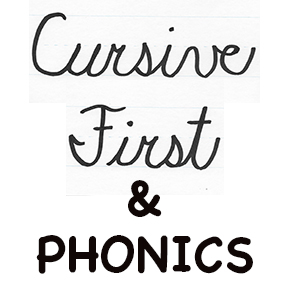We are offering computer classes for … Beyond the code 6th-12th grades. STEM classes focused on technology including digital forensics, cyber security, IoT, and Linux.
Homeschooling Methods
We’ve talked about the broad types (or categories) of homeschool curriculum. As a previous public school teacher, I have a comfort level in this area. However, applying that knowledge to the myriad of products available- each of which will tell you theirs is the best- is a different story! Hopefully the podcast has given you a skeleton of understanding.
I attended Jeannie Fullbright’s session called “The Seven E’s for Choosing Curriculum” at the Teach Them Diligently homeschool conference. One of the areas that this session helped me was by outlining the different METHODS of homeschooling. Obviously I didn’t do my research homework before I began homeschooling! My goal is not to write a paper on this topic but to rather give you a skeleton of understanding behind some of the most popular methods. There is some overlap between the methods and the types of curriculum (note that one could substitute the words “philosophy” or “approach” in place of the word “methods”). For example, textbook and unit studies are BOTH methods and a type of curriculum that can be bought (see last post & chart for explanation of these two). I want to discuss the Classical, Charlotte Mason, and Child Directed methods today.
The Classical approach is systematic and rigorous and finds its’ roots back in the way the Greeks/Romans educated. It is focused on the written and spoken language rather than images or videos. There is an emphasis on the great works of literature from Plato, Aristotle, Swift, and Dickens, to name a few. “It follows a specific three-part pattern: the mind must be first supplied with facts and images, then given the logical tools for organization of facts, and finally equipped to express conclusions.” It is believed that all learning is interrelated and uses history as the connection between all these areas. There are three stages of learning. The Grammar Stage, grades 1-4, are spent sponging up facts and memorizing. The Dialectic Stage (or logic stage), middle school, focuses on the the cause and effect between subject areas and are able to understand the framework they fit into. The last stage of learning is the Rhetoric Stage where the child learns to write and speak with elegance. http://www.welltrainedmind.com/classical-education/
Charlotte Mason trained governesses who schooled children in the 1800’s. She believed that ⅓ of a child’s education came from home environment, another ⅓ from the discipline of good habits/character, and the last third from academics. In general this approach is gentle rather than rigorous. The lessons are short with focused attention- lengthening as they get older. Charlotte believed that children should be given good quality “living” books rather than dry dull textbooks for the subjects of history, geography, science and literature. Science was spent observing nature and recording observations in a “nature notebook”. Math is stresses the importance of understanding the why of a concept and using manipulatives as a tool to learn this before pencil and paper work begins. A key component of the Charlotte Mason method is the use of “narration” to learn and retain information. I will do a whole topic on this method in the future but for now let me say narration is when a child tells back in his own words what he saw, read, or heard and it can be done orally or written. Narration is the opposite of textbook assessments. http://simplycharlottemason.com/basics/started/charlotte-mason-method/
The last method has several names that are varying degrees of the same method; Child Directed, Delight Directed, or Unschooling. The underlying philosophy is that all kids naturally want to learn and they will excel when left to their own devices to explore what interests them. This method of schooling sounds very much like the trend of “child-centered parenting”. It leaves an unanswered question of “What about subjects’ children aren’t particularly interested in, but need to know?” Some “Unschoolers” provide some structure and make sure their child is doing a math curriculum.
Read more at Suite101: Homeschooling Trends: The Trend for Child-Led UnSchooling in Homeschooling Homes | Suite101.com
As I type this I am wondering just how many more philosophical methods there are (or will be) to home educating. Is it any wonder so many of us are bogged down and overwhelmed as we begin the process of teaching our children?
“What has been will be again, what has been done will be done again; there is nothing new under the sun. Is there anything of which one can say, “Look! This is something new”? It was here already, long ago; it was here before our time.” Ecclesiastes 1:9-10 NIV
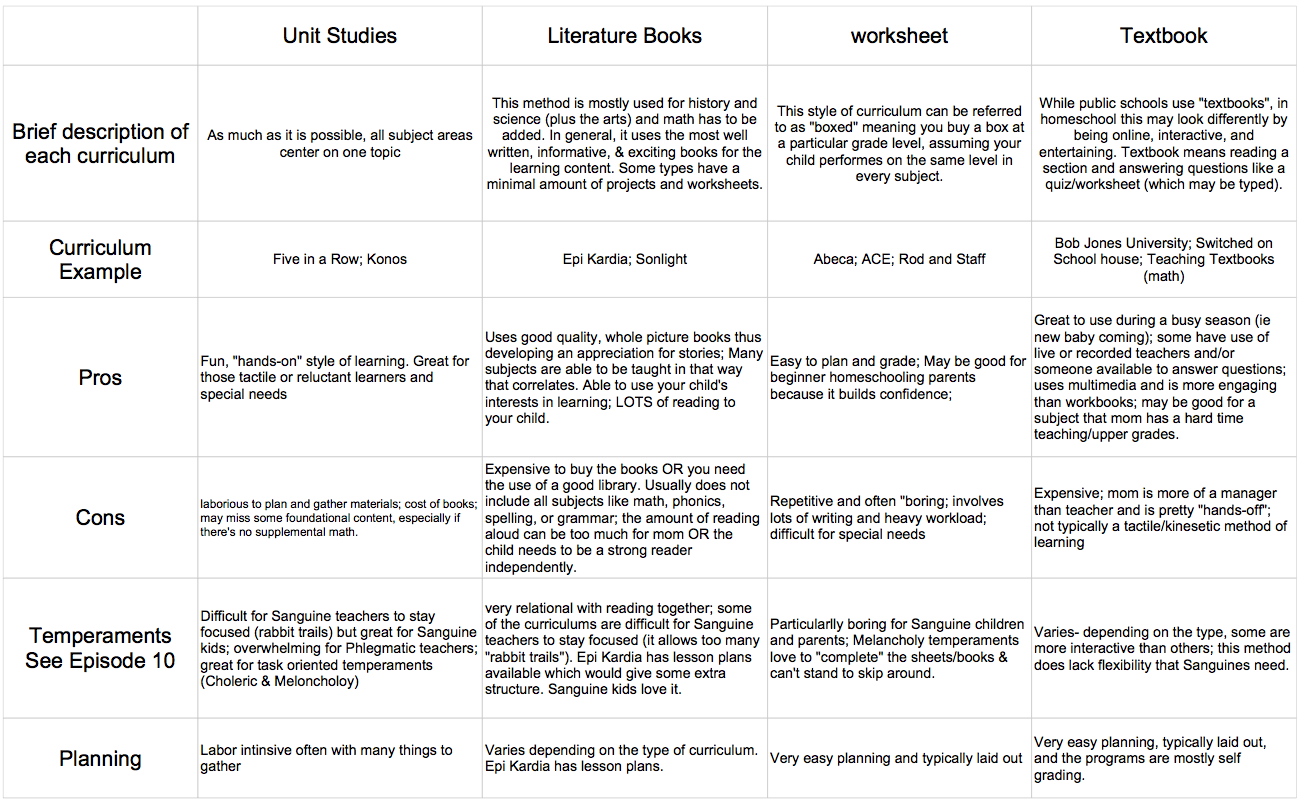
Curriculum Types

Podcast: Play in new window | Download
Subscribe: Apple Podcasts | RSS
Giveaway: God’s Design for Life: The World of Animals
Details: This is a $24.99 value. Shipping within the USA will be paid by us.
How To Enter: Register for our mailing list using the form below.
Deadline to enter: April 2, 2012 Midnight Eastern Time
Bouns Entry Methods:
Tweet a link to our blog**
Link to us on Facebook**
**Please comment below in this post and let us know that you did these bonus actions.
Our goal in this episode is to equip you with some basic knowledge of the types of curriculum with some pros and cons of each. This is so that you can identify what your educational styles are and what some curricula choices are that matches your style. This BY NO MEANS is intended to be an an all inclusive list! There’s no way to know all that is available on the market- it changes too fast!
If you learn the basic categories that most curriculum falls into then you can identify it yourself. This is especially helpful when you go to curriculum fairs, homeschool conventions, or think you might like to try your friend’s favorite curriculum.
I personally believe that the most rounded education comes from using a variety of types. EVERY product available is going to have holes or at the very least, disadvantages. My best friend watched me run in circles trying to find the “perfect” curriculum when I began home schooling. I did finally realize there was no such thing because I didn’t write it (coming up with my own thing was time consuming, exhausting and at times- expensive).
I have also learned there is a “season” for every type of curriculum to be used- by most people. For example, a workbook curriculum might be necessary in one subject or in a season of context (new baby or moving) even if it is not your preferred method. Or you might need to use a unit approach to get your reluctant learner excited about learning.
The 4 types of curriculum that we are going to compare are:
Workbook*
Textbook*
Unit Study
Literature Books
*Because of the similarities between these two, it can be difficult to define the difference because most textbooks also have a workbook component and vice versa.
Below is a chart that we mentioned in this episode of the HSSN Podcast. This chart shows the Pros, Cons, Planning, Temperament, and example notes for each homeschool curriculum type.
Also mentioned in this episode is an episode of the DaddyLife.net Podcast discussing Love Languages and HSSN Podcast Episode 10 on Temperaments.
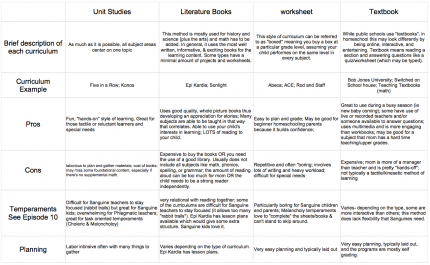
Subscribe:
You can subscribe to this podcast via iTunes and/or RSS below:
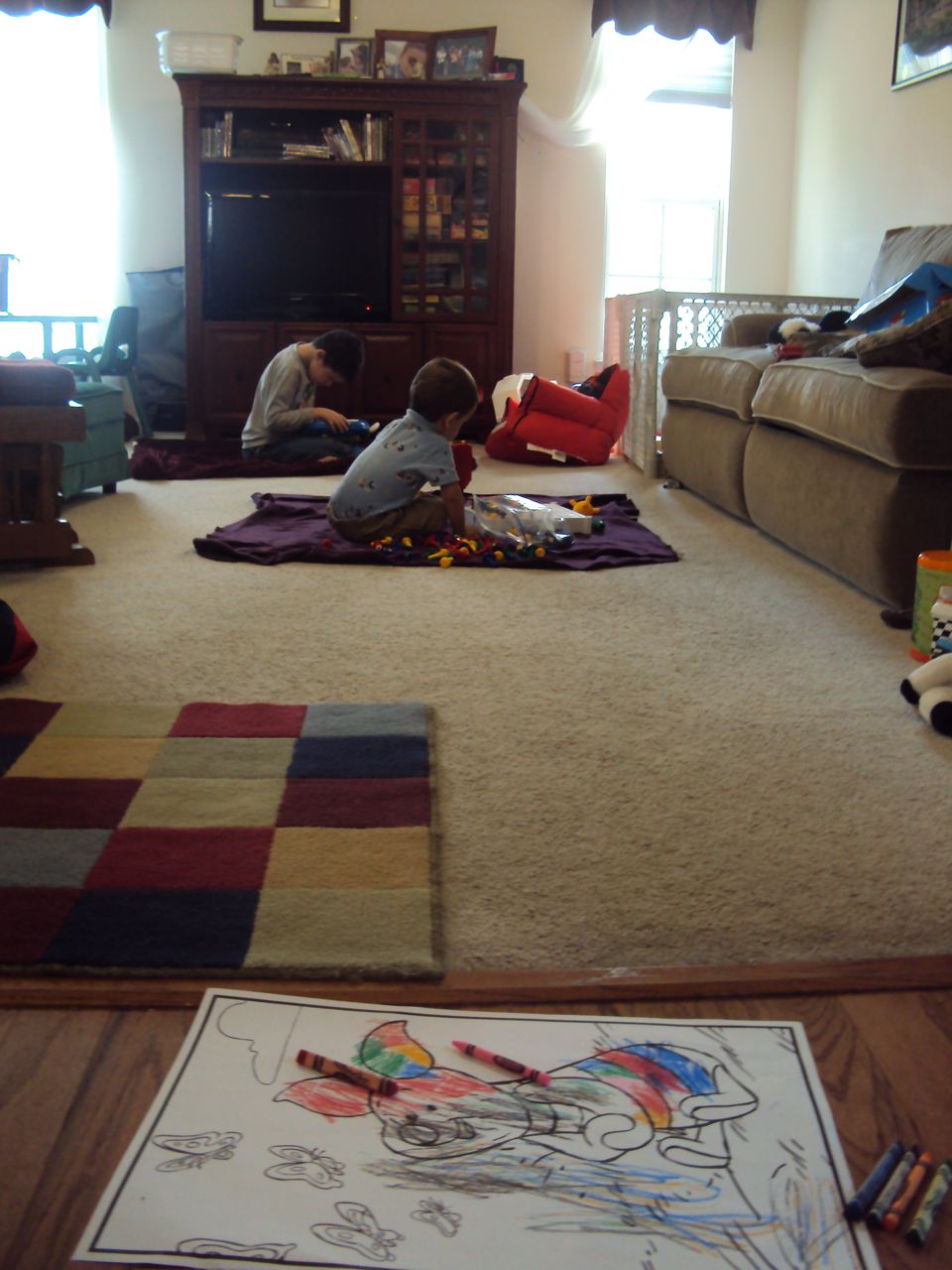
Juggling a Houseful with Learning Stations
“Children are a blessing from the Lord; they are a reward from him.”
Psalm 127:3 NLT
Ever been at your whits end trying to juggle your “blessings” all the while accomplish schooling with one or more of those same blessings?! Time management is the key!
We’ve talked about Structure and Routine in Episode 5 and a part of that structure is training your children to stay within boundaries set by mom. We started with training “blanket time” for the boys when they became mobile. I would put down a blanket with a few toys on it and set a timer. Each time they went to crawl off, I would redirect them back on the blanket. If you keep some toys set aside to use for blanket time then they maintain their novelty and can successfully lengthen this time once it has been trained.
With a houseful of siblings, that blanket time is often seen as a relief to have their “own” space marked off as theirs! I have found that “blanket time” doesn’t HAVE to be just for toddlers, in fact it illuminated an area that needed training in my 4 ½ year old today. You will notice there is a child missing from the picture above because he was on his bed working on his obeying without complaining as he was not happy with the choice of activity I gave him (coloring sheet). This is character training, and is the main reason our family has decided to homeschool. This is also school!
There are several different ways to use the blanket boundaries for school teaching time and for structuring preschoolers so you HAVE TIME to teach (and yes, house cleaning too!)
I have taken that blanket time training (which I learned about from On Becoming Toddlerwise) and blended it with a teaching practice of “learning centers”. This is where you have several areas of learning activities set up throughout a room and the children are rotated through these centers. You can use these educational activities for school and swap children after a determined amount of time. All the while, mom is available assisting and redirecting those little ones, working on behavior, or doing some chores.
Another use is to give the children relatively independent activities so mom can have some one-on-one time to work on a subject with another child. Do realize that if you have toddlers, mom needs to be able to pause this instruction time to redirect the little ones (so save the very difficult subjects for when the little ones are napping or resting on their beds). If mom doesn’t insist the little ones stay on the blanket, then they will stop doing so and this tool is no longer usable.
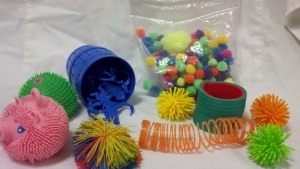 I also use these boundaries and small, quiet toys (what my son’s occupational therapist calls “fidgets”) for when I have a good amount of reading aloud to them. We start reading on the couch and I dismiss them to their blankets once they have done all the sitting I can reasonably expect. It looks sort of like a train making stops letting off passengers. I use this method instead of having the child go play somewhere else because if they are in the same room they are still absorbing information. The only caveat is that they play quietly or they loose the freedom to play with their “fidget”. I use mainly sensory items as fidgets (meaning they are squishy, stretchy, or textured). You can check out a special needs catalogue such as Abilitations or try a craft store like Michaels. Our favorite fidgets are various size pompoms. This method works great for my special needs son and for the younger ones (4-6 year olds) but NOT for the toddlers! When I have a lot of reading that is when I put the toddler in his Pack and Play in the other room with a few toys (basically “blanket time” but with the physical boundaries).
I also use these boundaries and small, quiet toys (what my son’s occupational therapist calls “fidgets”) for when I have a good amount of reading aloud to them. We start reading on the couch and I dismiss them to their blankets once they have done all the sitting I can reasonably expect. It looks sort of like a train making stops letting off passengers. I use this method instead of having the child go play somewhere else because if they are in the same room they are still absorbing information. The only caveat is that they play quietly or they loose the freedom to play with their “fidget”. I use mainly sensory items as fidgets (meaning they are squishy, stretchy, or textured). You can check out a special needs catalogue such as Abilitations or try a craft store like Michaels. Our favorite fidgets are various size pompoms. This method works great for my special needs son and for the younger ones (4-6 year olds) but NOT for the toddlers! When I have a lot of reading that is when I put the toddler in his Pack and Play in the other room with a few toys (basically “blanket time” but with the physical boundaries).
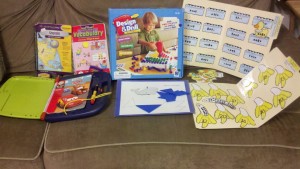 Ideas for learning centers:
Ideas for learning centers:
Leappad electronic games with educational game cartridges (many of these are retired by Leap Frog but are worth the hunt)
TAG Reader (also by Leap Frog)
Discovery Toys “Playful Patterns”
Discovery Toys “Learning Bugs”
Discovery Toys “Think it Through Tiles”
Tangrams with patterns
Lacing cards – fine motor skills
Design & Drill – copying patterns & fine motor
File Folder Games
puzzles
coloring or activity book
picture books
- « Previous Page
- 1
- …
- 6
- 7
- 8
- 9
- 10
- …
- 13
- Next Page »
